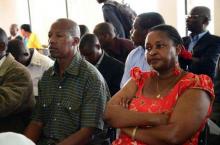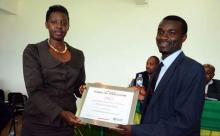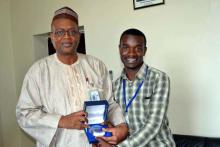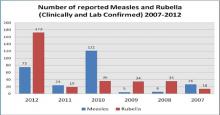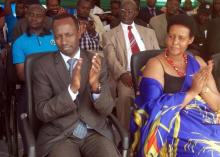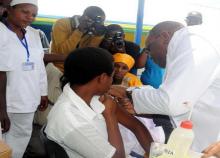The World No Tobacco Day 2013 in Rwanda
« Second hand smoke kills »
Rwanda has celebrated the World No Tobacco Day on 14 June 2013. The theme worldwide was "Ban to Tobacco advertising, promotion and sponsorship". In Rwanda, the theme has been adapted to the current priority in fighting against tobacco, which is "Second Hand Smoke Kills".
Activities along the previous week to the celebration day were oriented to sensitization activities reminding communities to not smoke in public places and closed areas. The messages were conveyed to general public but especially to young people.
The ceremonies of the World No Tobacco Day took place at Burera District, Nothern Province. The Guest of Honor was the Minister of State in Charge of Public Health and Primary Health Care in the Ministry of Health. Many other partners and local authorities and population participated in the event. Among them, the Governor of Northern Province, the Mayor of Burera District, the delegate of the World Health Organization Representative in Rwanda. The Directors of District Hospitals and Districts Socio Affairs Officers participated to the ceremony.
All the messages at this occasion, starting by the Minister of State, have highlighted how tobacco is very harmful to health of an individual but also to the family, and communities: "Tobacco is a big killer".
The diseases caused by tobacco, such as many cancers of mouth, throat, lung,... , the link with cardio vascular diseases, hypertension, diabetes... constitute a big burden to an individual, family and the country as a whole.
The speakers urged smokers to respect the rights of non-smokers, and always use remote areas for smoking. They called upon all partners, educators, youth associations, civil society, NGOs, to join the fight against tobacco and protect especially young people from tobacco use. The messages reminded people that Tobacco Industries have many malicious strategies for attracting people to smoke!
Other speeches at the ceremony were from the Governor of Northern Province and WHO delegate. Local and international media working in the country have covered the ceremony and disseminated the information countrywide.
At the ceremony, the national new Law on Tobacco Control has been launched and presented to the country officially. The Law has been published in Official Gazette in April 2013. The Law is now a legal instrument that the country has to protect the rwandan population against tobacco harm. The Law will be disseminated and explained to all Rwandans by the Ministry of Health and its partners, with the big support of Local Government institutions.
During the ceremony, an award donated by WHO has been dedicated to a young student of Faculty of Medicine, National University of Rwanda, Mr Christophe Rusatira, for his commitment and engagement in fighting tobacco. Five people in the African Region received the award in 2013.
Integrated Measles and Rubella Vaccination campaign
Background and justification.
Rwanda covers an area of 26,338 km². The population projection from the 2012 census gives a population of 10,811,190 inhabitants in 2013. The population density is 410 inhabitants per km². It has 5 provinces, 30 districts and 417 sectors. Estimates of the most recent demographic data set at 4.1% the proportion of live births, 3.8% surviving children at the age of one year, 2.1% of those 6-11 months, 1,025% of those 9-11 months, 23.6% of women of childbearing age, 0.5% in lactating women postpartum, and 39.575% of children 9 months to 14 years. Thus the expected target for this campaign was 4,278,528 children for immunization against measles and rubella.
Efforts to implement the strategy of Integrated Management of communicable diseases of childhood and the introduction of new vaccines contributed to the notable reduction of infant mortality rates and under 5 as shown in following table:
Trends of Infant and child mortality rate/ 1 000 live birth: 2000-2011
Rwanda has made tremendous progress in reducing child mortality since 2000. Vaccination has played a major role in the fight against childhood diseases. Indeed immunization coverage for all antigens reached and maintained more than 90% since 2005. Rwanda has 11 antigens in the routine immunization program since 2012 and next year in 2014, the country will introduce Rubella vaccine in its routine vaccination program. The eradication, the elimination and the control of vaccine preventable diseases will certainly contribute to achieve the MDG 4 which is to reduce by 2/3 the child mortality by 2015.
Despite these advances, there has been an upsurge of measles cases that are probably related to the failure of this vaccine antigen when administered before one year and also to the existence of pockets of low coverage in some health districts. Note also that the epidemic peaks caused mass vaccinations or strengthening routine immunization in the districts concerned. Search for rubella in the negative samples of measles confirmed the existence of cases of rubella in Rwanda. The table below shows the coexistence of measles and rubella in Rwanda.
Measles and Rubella cases in Rwanda 2007-12
This situation has led Rwanda health authorities to consider rubella as a public health problem and thus organize integrated immunization against measles and rubella campaign.
Committed to achieving by 2015 the fourth goal of the Millennium Development, Rwanda has decided to expand the range of vaccines and EPI population target. So to celebrate the African Vaccination Week 2013 edition, the Ministry of Health of Rwanda in collaboration with its partners decided to introduce in its routine immunization program the combined vaccine against measles and rubella. The introduction of this vaccine was first made in the form of campaign targeting children aged 9 months to 15 years, and will continue in 2014 in an integrated way in the routine EPI schedule to serve opportunity to administer a second dose of vaccine against measles for children from one year. The organization of this campaign also helped to vaccinate teenage girls against cervical cancer and to supplement vitamin A, children 6 months to 5 years and lactating women postpartum.
Objective of the campaign
Overall, the campaign aimed to accelerate the reduction of infant mortality due to vaccinepreventable diseases, and contribute to achieving the fourth goal of the Millennium Development Goals. More specifically, the campaign is expected to administer a second dose of measles vaccine to children 9 months to 15 years, to prepare health workers and the community to the introduction of the combined vaccine Measles / Rubella in the routine EPI as opportunity to provide a second dose of vaccine against measles and increase coverage against the cervical cancer in young girls 9 to 14 years, and supplement more children and postpartum women with vitamin A.
Organization of implementation
The pattern of implementation of this campaign was structured in the following three phases:
a. The preparatory phase which included the development of micro plans at central level and in the health districts, review of media collection and the database to reflect the new combined measles rubella vaccine supplies and consumables and finally, training of health workers and community awareness;
b. The phase of implementation which included the official launch of the campaign, the administration of vaccines and vitamin A, the collection of data and daily transmission, supervision and monitoring in process;
c. Post campaign including the organization of workshops to validate the administrative data using independent survey coverage at the community level, providing the information back to the WHO Country Representative and partners (ICC).
Administration of vaccines and vitamin A supplementation
In total 6000 sites have been created, including fixed health facilities, schools and vaccination posts at Community level routinely used as vaccination sites during outreach strategy. A vaccination team was composed at Community level by a vaccinator who administered injectable vaccines, an person to register children on the cards, an person to point vaccinated children on daily time sheets, an person who administered vitamin A and an person to ensure order. At the school level, the team included a vaccinator, a teacher and a community health worker. The daily performance of a team was between 125 and 150 children vaccinated per day at Community level and fixed site while it was 200children vaccinated at school sites.
Collection and transmission of data
Data collection was done on daily basis on appropriate tally sheets including antigens provided as well as vitamin A. Health workers were trained prior to fill the sheets. Every evening the data were compiled at the health center and sent to district / hospital. The district was in turn compiled data from health centers and transmitted at central level. Information for Action was shared as feedback by phone and allows solving many problems identified.
Organization of supervision and monitoring in process
Supervision was organized in two phases. The preparatory supervision which has the objectives to ascertain the status of preparatory activities focusing on social mobilization, implementation of vaccines, supplies, transportation logistics and funds for operational costs. Overseeing the implementation phase, which focused on the vaccination act, the collection and transmission of data, injection safety and identification of insufficiently covered areas by a monitoring in process. In case these poorly coved areas were identified, mop up vaccination was organized.
Measles and Rubella vaccine Launching
Rwanda has officially introduced the combined measles and rubella vaccine in its immunization program on 12th March 2013. The launching ceremony took place in Nyaruguru District, Southern Province, as part of the integrated Child and Adolescent Health Week organised from 12 to 15 March 2013. The Guest of Honour of this ceremony was the Minister of Gender and Family Promotion, other guests were the Permanent Secretary in the Ministry of Health and the Governor of Southern Province. The United Nations Agencies were represented by WHO and UNICEF Representatives. A representative of GAVI also attended the event.
WHO role in Measles/Rubella Control
WHO has played and continues to play a vital role as a key partner of the Ministry of Health in the vaccination program. In the preparation to introduce Rubella vaccine into routine vaccination WCO worked closely with Ministry of Health in the elaboration and submission of its application to GAVI to be eligible for the vaccine. WHO Country Office worked also with Vaccine Preventable Disease Division in planning, implementation and evaluation of MR SIAs.
WHO has availed 4 Consultants to support Ministry of Health in vaccine logistics, campaign design and implementation and conduct the independent evaluation of the campaign. WHO also supported a study to estimate the burden of Congenital Rubella Syndrome and to put in place surveillance of Measles and Rubella through the National Reference Laboratory.
Integrated Measles Rubella Vaccination campaign results
A total of 4,389,770 children were vaccinated against measles / rubella on a target of 4278 528 children 9 months to 14 years, representing a coverage rate of 102.6%. This coverage, however, hides disparities between age groups and between districts. The best being that covered children aged 5-14years with 110% coverage, the least covered being that children 12-59 months with 89% coverage range. The worst performing district was GASABO with immunization coverage of 81%.
Except Gasabo district, all other districts have experienced a higher coverage above 90% and 90% have experienced a coverage more than 95%.On vitamin A supplementation, coverage is only 86% of children 6-59 months. The national HPV coverage was 99% for both P6 and S3 grades school girls and girls in the out-of schools was 103%.
Adverse Effects Following Immunization ( AEFI) identification and reporting
Except 4 districts, all the districts reported AEFI and managed at the health center level. There were 315 AEFI cases reported from 26 districts and none of them were serious.
AEFI surveillance was done in an integrated way in the collection system and daily data transmission of the campaign. Vaccinators were trained and sensitized to the detection and orientation of AEFI to health centers and hospitals for free care. In total 315 AEFI were reported by 26 of the 30 health districts. No cases of death or hospitalization due to AEFI have been reported during this campaign. Note also that no impact these have had on the normal course of the campaign.
Strengths of the campaign
- Effective communication channels used to convey campaign messages (Parents and targets informed about the dates and locations of vaccination);
- Ownership of the campaign by the authorities (strong involvement in the awareness and implementation of the campaign);
- Technical and financial support provided by partners of the Ministry of Health in organizing the campaign;
- Good micro-planning at all levels has helped to mobilize resources to meet the needs of the campaign;
- Good functioning of local committees organizing the campaign;
- Preventive management of refusals which helped dispels some rumors about new vaccines;
- Supervision of the preparatory phase at the central level;
- Availability of vaccines and other supplies and provision of health centers in time;
- Support from central level to supervise activities at district level;
- Application of LQAS in the monitoring process which helped to detect insufficiently covered areas and proceed to mop up vaccination;
- Injection safety ensured at all levels;
- No serious AEFI identified.
Weaknesses of the campaign
- Poor collaboration of teachers in some sites;
- Failure in some sites in organizing the logistics of transportation, which delayed the departure or return of the vaccination team;
- Rwanda is sharing border with 4 countries namely DRC, Burundi, Uganda and Tanzania and there are significant mobility of the people every day. There was no cross border mapping, micro-planning and coordination meeting conducted prior to the campaign. Last coordination meeting was held on 30th September, 2009 with DRC.
Integrated Measles Rubella Post campaign and Routine Immunization Coverage Evaluation Survey 2013
Objective of the Survey
Rwanda is the first African country to conduct an integrated MR campaign. Also Rwanda is the first African country to conduct a nationwide integrated RI and post MR campaign evaluation with sample size and methodology appropriate to get district level coverage estimates for all the 30 districts in Rwanda.
The General Objective is to validate the district administrative level coverage of interventions during the vaccination campaign against measles / rubella / HPV / Vit A in Rwanda from 12-15 March 2013.
The independent survey to assess immunization coverage showed that the children were well vaccinated for integrated vaccination campaign. Indeed all districts reported coverage of over 90%, although the recommended coverage is 95%. Coverage of more than 100% in some districts due to the overestimation of the total population or the proportions of the age to vaccinate poorly estimated.
Funding of the campaign
The Government of Rwanda has funded the campaign with international and local support. Among them, GAVI through WHO has contributed with USD 3 064 954 .The local contributions came from various partners: WHO, UNICEF, RED CROSS, ORINFOR, WORLD VISION, UNFPA, URUNANA Development Communication.
GAVI will support also the Rwanda with a cash grant of $ 0.80 per child in the birth cohort, as support to the country during the first year of introduction into the routine vaccination
Conclusion
Rwanda has made significant progress in achieving the fourth goal of the Millennium Development Goals. The mortality rate of children under 5 years was reduced by more than 50% in 5 years with the improvement of the management of communicable diseases of childhood and the introduction of new vaccines. No one can doubt the vaccine performances achieved by Rwanda. Indeed independent assessment survey confirms vaccination coverage administrative data that Rwanda shares with its local and international partners. This good performance is testified by immunization rates exceeding 90% immunization coverage for all antigens and for more than decennia. The introduction of the combined vaccine in routine immunization as an opportunity to give a second dose of vaccine against measles in children contribute to the elimination of measles in Rwanda and control certainly infant mortality. This requires countries to maintain its high level of political and financial commitment for immunization activities support. International partners should continue to support Rwanda in its development efforts to improve health population and the community to take greater ownership of the management of health programs and mobilize local resources to support them.




